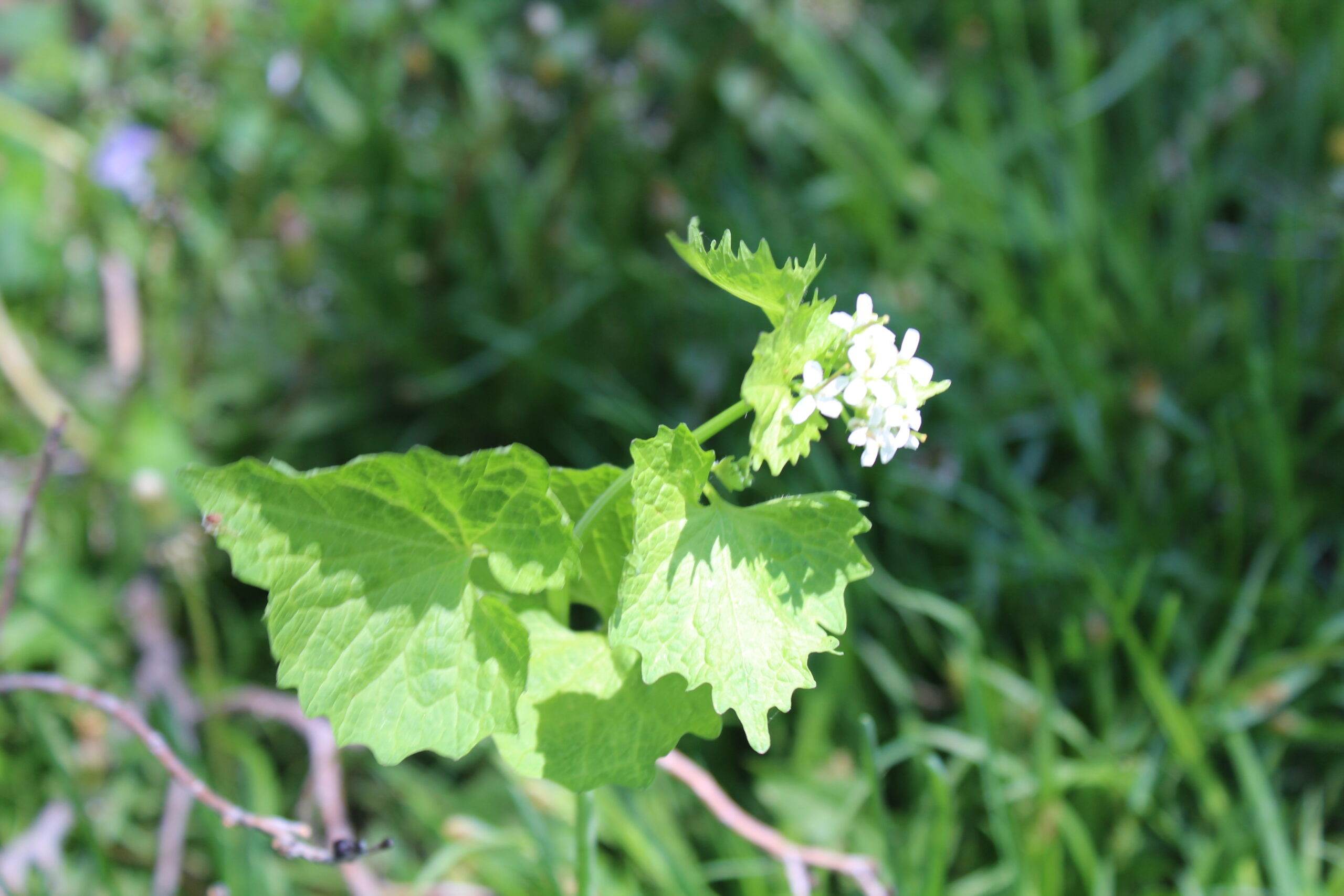One of the earliest plants we see in the spring is known as garlic mustard (Alliaria petiolata). It is a member of the mustard family. It gets its name because all parts of the plant taste like garlic. Deer won’t eat it, and other native herbivores such as rabbits, geese, opossums and native insects don’t like it either. Unfortunately, garlic mustard is very aggressive and crowds out the plants our natives do like to eat.
As a biennial plant, it takes two years to complete its life cycle. In its first year, it hunkers close to the ground growing a rosette of leaves around its base. The leaves are about four and a half inches long with toothed edges and rounded ends. The second year, it grows one or two stalks up to three feet tall from the center. Little four-petaled white flowers bloom in May and June. The flowers may self-pollinate or be pollinated by insects. They set seeds by developing long, four-sided seed pods loaded with rows of tiny black, oblong seeds. The pods will dry and open, scattering myriad seeds on the wind. A single plant can produce between 6,000 and 7,500 seeds.
The garlic mustard has a white taproot that is S-shaped at the top. The roots aren’t very deep, but they sometimes break off when the whole plant is pulled out of the ground.
Garlic mustard is not native to the Americas. It came, like so many other invasives, from Europe. It was imported to use in medicines to treat gangrene and bronchitis. It escaped cultivation and was first seen wild on Long Island in 1868. Today, garlic mustard has invaded at least 34 states across the U.S. It’s very hard to control. Pulling each plant out by the roots before it sets seeds is the best way to control it, but that’s a bit impractical in large infestations.
Garlic mustard uses several natural defenses to crowd out native plants and take over forest floors, savannas, roadsides and other disturbed areas. Because it tastes bad to both animals and insects, it is not controlled by being eaten. It begins growing earlier in the spring than native plants, giving it a head-start on crowding them out. It also spreads allelopathic chemicals in the soil that damage or kill other plants. The mycorrhizal fungi that trees depend on for their underground networks also succumb to these chemicals, and this in turn damages or kills young trees. In addition, garlic mustard seeds can remain viable in the soil for several years, germinating when the conditions are right. With these weapons, the garlic mustard can literally take over a forest or a savannah.
One of the notable casualties of garlic mustard is the white butterfly. It plans to lay its eggs on toothwort plants which are closely related to mustards, but when the toothworts are missing, the butterflies lay their eggs on garlic mustard instead. The caterpillars eat the garlic mustard, and more often than not, die of its poisons.
Garlic mustard is only one of an entire family of plants, and a few of them have been prized and cultivated for five thousand years as a spice and as a medicine. The two types of mustard in my refrigerator come from two of these species. White mustard is the basis of the yellow mustard that we put on hotdogs and hamburgers. A different mustard plant, originating in the Himalayas yields the brown mustard I’m particularly partial to. Another variety of mustard called black mustard originated in the Middle East and Asia. It outdoes hot peppers in its spiciness in Indian and Chinese restaurants. The name mustard is thought to come from the Latin for must, as in grape juice, and ardens, meaning burning because the ancient Romans mixed hot mustard seeds with must, making a “burning must” for the table.
To make these condiments, the mustard seeds are gathered and ground to a powder. A liquid such as vinegar is added along with other spices. Today, mustard for commercial processing is grown in Canada and the northwest United States.
Although the deer and rabbits won’t eat the garlic mustard on Owl Acres, food foragers declare all parts of the plant to be tasty and wholesome. I have no objection to garlic per se, so maybe we’ll give it a try.
Photo by Author. Alt text: Tender leaves and delicate, white flowers of Garlic Mustard belie this aggressive invader’s ambition of world domination.
